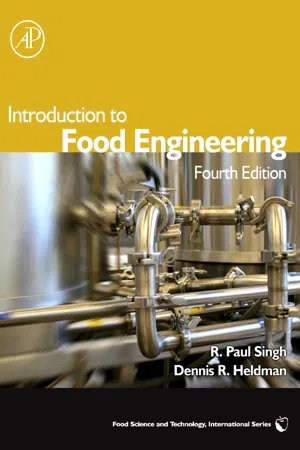
Introduction to Food Engineering
- 864 pages
- English
- ePUB (mobile friendly)
- Available on iOS & Android
Introduction to Food Engineering
About this book
This fourth edition of this successful textbook succinctly presents the engineering concepts and unit operations used in food processing, in a unique blend of principles with applications. Depth of coverage is very high. The authors use their many years of teaching to present food engineering concepts in a logical progression that covers the standard course curriculum. Both are specialists in engineering and world-renowned. Chapters describe the application of a particular principle followed by the quantitative relationships that define the related processes, solved examples and problems to test understanding.- Supplemental processes including filtration, sedimentation, centrifugation, and mixing- Extrusion processes for foods- Packaging concepts and shelf life of foods- Expanded information on Emerging technologies, such as high pressure and pulsed electric field; Transport of granular foods and powders; Process controls and measurements; Design of plate heat exchangers; Impact of fouling in heat transfer processes; Use of dimensional analysis in understanding physical phenomena
Frequently asked questions
- Essential is ideal for learners and professionals who enjoy exploring a wide range of subjects. Access the Essential Library with 800,000+ trusted titles and best-sellers across business, personal growth, and the humanities. Includes unlimited reading time and Standard Read Aloud voice.
- Complete: Perfect for advanced learners and researchers needing full, unrestricted access. Unlock 1.4M+ books across hundreds of subjects, including academic and specialized titles. The Complete Plan also includes advanced features like Premium Read Aloud and Research Assistant.
Please note we cannot support devices running on iOS 13 and Android 7 or earlier. Learn more about using the app.
Information
Chapter 1. Introduction
1.1. Dimensions
All icons in this chapter refer to the author's web site, which is independently owned and operated. Academic Press is not responsible for the content or operation of the author's web site. Please direct your web site comments and questions to the author: Professor R. Paul Singh, Department of Biological and Agricultural Engineering, University of California, Davis, CA 95616, USA.Email: [email protected].
1.2. Engineering Units
Table of contents
- Brief Table of Contents
- Table of Contents
- Foreword
- About the Authors
- Preface
- Chapter 1. Introduction
- BibliographyBibliography
- Chapter 2. Fluid Flow in Food Processing
- BibliographyReferences
- Chapter 3. Energy and Controls in Food Processes
- BibliographyBibliography
- Chapter 4. Heat Transfer in Food Processing
- BibliographyBibliography
- Chapter 5. Preservation Processes
- BibliographyBibliography
- Chapter 6. Refrigeration
- BibliographyBibliography
- Chapter 7. Food Freezing
- BibliographyBibliography
- Chapter 8. Evaporation
- BibliographyBibliography
- Chapter 9. Psychrometrics
- BibliographyBibliography
- Chapter 10. Mass Transfer
- BibliographyBibliography
- Chapter 11. Membrane Separation
- BibliographyBibliography
- Chapter 12. Dehydration
- BibliographyBibliography
- Chapter 13. Supplemental Processes
- BibliographyBibliography
- Chapter 14. Extrusion Processes for Foods
- BibliographyBibliography
- Chapter 15. Packaging Concepts
- BibliographyBibliography
- Appendix Appendices
- Bibliography